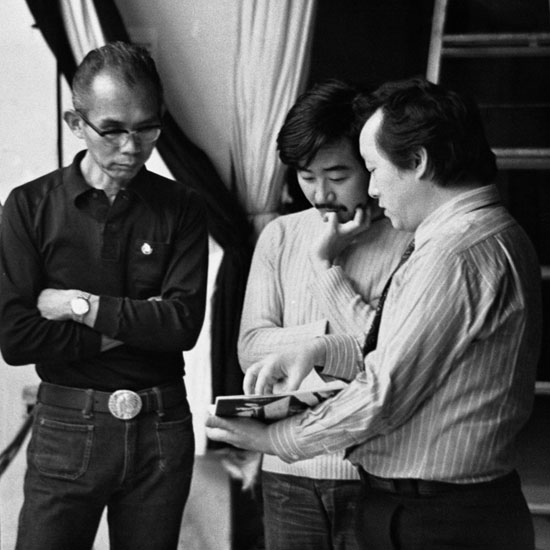田中一光のアートディレクション
小池一子 (クリエイティブディレクター)
グラフィックデザインは文字、色、紙の三要素からなりたっていると田中一光はよく語っていた。そのグラフィックデザインの領域で成し遂げられた美しい仕事の数々はポスター、作品集の他、ロゴタイプ、ショッピングバッグなどで没後10年の今も日常的に一般の人々の目に触れるものになっている。
さらに田中一光の仕事は、アートディレクターという大きな立場で建築空間や商品企画を含む長・短期のプロジェクトや事業に展開されている。
それら膨大な作品群を貫く軸を見つけることで田中一光のアートディレクションの特質を引き出す試みを私は一つの展覧会に投入した。田中の自著からの引用であるタイトル、「田中一光とデザインの前後左右」展がそれである。
DNP文化振興財団所蔵のアーカイブを基に展示主題を抽出したが、最重要と思われたのは、日本のヴィジュアルな文化遺産の咀嚼、再創造ともいうべき仕事の系譜である。
紋典、植物図版などのアノニマスな作図に触発されて生み出されるイメージは印刷技法を駆使したプロセスを経て、現代の日本の表現として海外でも高い評価を得る作品となっている。“立ち上がる文様”と私は呼んでいるが、古い資料から取り出す図版の引用が印刷媒体のミニマルなものから壁画のようなマキシマムな視覚表現に展開される例などを見ると、一貫したアートディレクションの目と素材・技法をとりこんだ現実の場への定着力に驚かされるのである。「デザインの前後左右」という表現には、過去から未来にむかう縦軸と同時代感覚やグローバルな連携を含む横軸との接点に自らを位置づけた田中一光の思いがこめられている。現代の琳派と言われる由縁もここにあると思う。
Art Direction by Ikko Tanaka
Kazuko Koike Creative Director
Ikko Tanaka often said that graphic design was composed of three factors: letters, colors and paper. Even ten years after his death, an array of his beautiful works in addition to his portfolios, still delight the eyes of the general public in the forms of posters, logotypes, and shopping bags.
Ikko Tanaka’s work evolved into projects and business activities that included architectural spaces and product planning conducted from his significant position as an art director. I attempted to draw out the essence of Ikko Tanaka’s art direction in an effort to discover the central core of his vast body of work in an exhibition. This event was called “Ikko Tanaka and Future/Past/East/West of Design,” quoting an expression that Tanaka himself used. What I thought was to be of paramount importance was the lineage of his works that could be said to embody true appreciation or recreation of the visual cultural heritage of Japan.
Images were first generated with inspiration from anonymously created drawing figures such as botanical pictorial cuts. They were then put through a process that made full use of printing techniques to become works that are highly acclaimed as expressions of modern-day Japan. I use the term “patterns that rise up” to describe his work. Drawing figures that were taken from old materials evolved into minimal printed media as well as maximal visual forms such as murals. Looking at these examples, I am amazed by his consistent eye for art direction and ability to strike root in actual contemporary experience through his use of materials and techniques. Ikko Tanaka put himself at the junction of a vertical axis extending from the past to the future and a horizontal axis spanning the sensibilities of the current era and global collaboration. This is what is evoked in his expression, “Future/Past/East/West of Design,” and it could be the reason why he is called the modern-day “Rinpa.”
